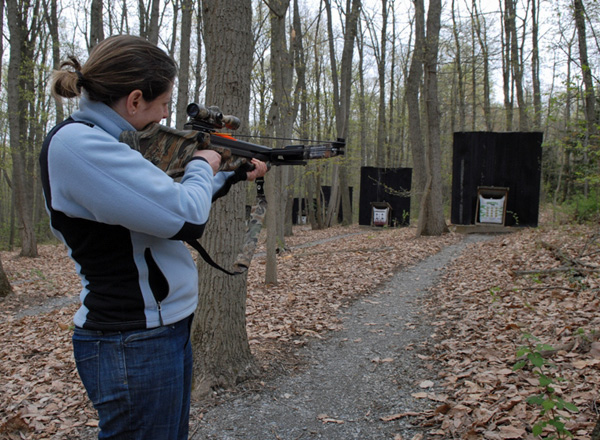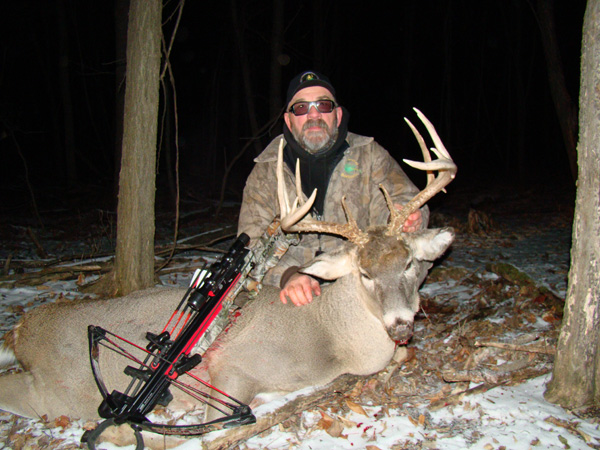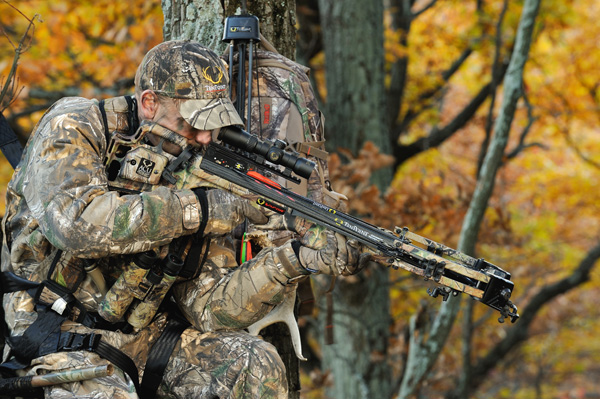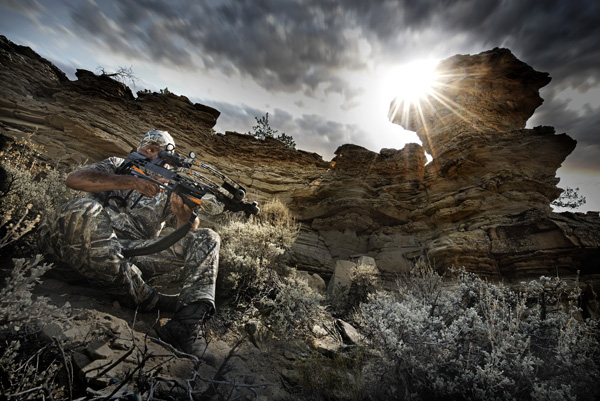LAST UPDATED: May 1st, 2015
Are crossbows affecting my bowhunting? Are they affecting yours?
It’s a fair question. And it’s one more of us are having to answer. Just a decade ago, if states allowed crossbows to be used at all for hunting, they usually were limited to handicapped or elderly hunters. That all has changed now.
Today crossbows can be used in 49 states. Oregon is the lone holdout. Twenty-five states basically consider crossbows to be like any other bow, allowing them to be used during archery-only hunting seasons by everyone.
That trend is not likely to change. Count on more and more states to remove the crossbow barrier with each passing season.
So what does that mean to the bowhunting community? Well, if you use a crossbow, you’re probably giddy. In most states, bowhunting-only deer seasons are held during the fall when the weather is nice, and they usually encompass all or part of the prime rutting period.
Crossbow proponents say the horizontal bows allow more people to get out into the woods. Kids, women, the elderly, people who don’t have time to master vertical bows all can become proficient with a crossbow in short order, making them lethal, effective hunters.

And if we can get more of America hunting, isn’t that good for everyone? Doesn’t that solidify a future for hunting?
Again – fair questions.
But it doesn’t mean everyone is jumping for joy over the expansion of crossbows. What does the rush to the woods by folks carrying crossbows mean to bowhunters who believe a bow shouldn’t be mounted to a rifle stock? Who believe bowhunting means drawing a bow by hand in the presence of game – not cocking it at home and carrying it around all day ready to shoot?
There’s no denying that when crossbows come on the scene in a new state, there is an impact. Take a look at what has happened in Pennsylvania.
Prior to 2009, if you wanted to use a crossbow during archery season, you had to get a note from a doctor stating that you suffered from some permanent condition that would impede your ability to draw a vertical bow. In 2009, the Pennsylvania Game Commission voted by the narrowest margin to allow crossbows to be used by all hunters during any archery season.
The vote touched off a massive controversy, because the overwhelming opinion about the issue expressed to the agency from the bowhunting community was, “Just say no.” But a majority of the commission members voted in favor of crossbows anyway, saying the move was needed to boost hunting participation.
And here’s what has happened since then. In 2003, the state sold 271,162 resident adult archery licenses. If you want to bowhunt deer during the archery deer season, that’s the license you need. That figure slid to 260,001 by 2008.
In 2009 – the first year crossbows were legal during any bowhunting season – the state sold 274,583 resident adult archery licenses. That figure has climbed every year since then, hitting 312,045 in 2013. That was the first time in nearly 20 years that sales of those licenses were above 300,000.
Love them or hate them there’s no question that crossbows are becoming increasingly popular and allowing more hunters into the woods during archery season. Photo courtesy of TenPoint Crossbows.
Now this rise in archery license sales coincided with a slide in general hunting license sales. In 2008, Pennsylvania sold 670,659 resident adult hunting licenses. Every hunter in the state needs one of these, whether they bowhunt or not. In 2013, the state sold 646,761 resident adult hunting licenses.
Junior hunting license sales also slipped during that period, dropping from 89,571 in 2008 to 87,194 in 2013. So at face value, it sure doesn’t look like the addition of crossbows boosted participation in hunting. What it looks like is a lot of gun hunters suddenly took up bowhunting. Do you think they picked up compounds or crossbows?
And what happened to the state’s deer kill? During the 2008-09 season – the last before crossbows were legalized – Pennsylvania deer hunters shot 335,850 deer, including 122,410 antlered bucks. Bowhunters accounted for 19 percent of the total kill and 26 percent of the buck kill.
During the 2013-14 season, hunters bagged 352,290 deer in all seasons, including 134,280 antlered bucks. Bowhunters accounted for 29 percent of the total kill and 37 percent of the buck kill.
The impact of crossbows? Well, during the 2008-09 season, crossbow hunters accounted for 24 percent of the archery harvest. During the 2013-14 season, they claimed 51 percent of the total archery kill.
Michigan started allowing crossbows during its archery seasons in 2009, although they were limited that year to hunters age 50 and older outside the southern Lower Peninsula. In 2010, the age restriction was eliminated. Michigan Department of Natural Resources indicated the inclusion of crossbows was done, like Pennsylvania, to expand hunting opportunities, retain existing hunters and to recruit new hunters.
A lot of what Michigan experienced with crossbows mirrored what happened in Pennsylvania. For starters, the state saw a decline in overall hunter numbers, dropping from 691,073 in 2006 to 648,127 in 2011. But at the same time, participation in archery hunting increased from 309,140 in 2006 to 321,869.
The number of archery hunters in Michigan was sliding along with the number of overall hunters until 2009, when crossbows entered the picture. That’s when the turnaround occurred for archery participation. While the state lost about 15,000 archery hunters from 2007-2008, it then gained back 20,000 archery hunters in 2009.
Once again, at face value it looks like crossbows didn’t bring any new hunters into the fold in Michigan, but rather, they simply allowed gun hunters to take up bowhunting. And in a 2011 survey, that’s basically what hunters told the Michigan Department of Natural Resources.
About 25 percent of the crossbow hunters in 2011 reported they had not hunted in archery season during the three years before crossbows were legalized. Roughly 19 percent of those crossbow hunters said they hunted only with guns before 2009. But that means, in turn, that 81 percent of crossbow hunters were bowhunters prior to 2009. So a majority of crossbow hunters in 2011 had used compounds and/or recurves previously.
At face value it appears that many vertical bow hunters are taking up the crossbow for one reason or another. Photo courtesy of Mission Crossbows.
A Pennsylvania survey in 2013 turned up very similar statistics. There, 94 percent of crossbow hunters surveyed said they also hunted with a recurve and/or compound. So it seems that gun hunters aren’t the only ones picking up crossbows. Bowhunters are choosing them too, once they become legal.
Looking at the figures from Michigan and Pennsylvania, it’s hard to make the case that crossbows are bringing new hunters to the game. But it wouldn’t be a stretch to say that crossbows are helping to retain hunters. In Pennsylvania’s 2013 survey, 53 percent of crossbow hunters said they would not participate in archery hunting if crossbows were not allowed. Seventy percent flat out said they prefer crossbows to other bows as they’ve gotten older because they’re easier to shoot.
Some members of the Pennsylvania Game Commission have said they are concerned about the increasing archery kill each year. Die-hard gun hunters, they’ve said, are watching bowhunters kill more and more deer every year, leaving less deer in the woods by the time gun season rolls around in late November.
Certainly no one is preventing those hunters from picking up a crossbow, longbow or compound and taking part in the archery season themselves, but the commissioners have said many are only interested in gun hunting. That’s their tradition. And they don’t necessarily like seeing the bowhunters claim a bigger slice of the herd year after year.
The agency’s biologists, too, have said it’s possible that if the state’s buck kill keeps growing during archery season, there could come a time when they would cut back on the archery season length. Right now, it’s six weeks long. If a reduction occurs, then all Pennsylvania bowhunters will see a definite negative impact on their hunting, that likely will be blamed on crossbows, because the kill numbers have only increased since crossbows became legal.

Ohio is the granddaddy of all crossbow hunting states. They’ve been doing it there longer than anyone. And bowhunters and deer managers there say Buckeye hunters have grown to view the crossbow as just another bow.
But when they are new to the mix, crossbows do have an impact on bowhunting. More people hit the woods during archery season, and the deer kill during that season increases. Whether you view those as positives or negatives is your call.
What’s your opinion? Let us know in the comment section below.

 By
By 





